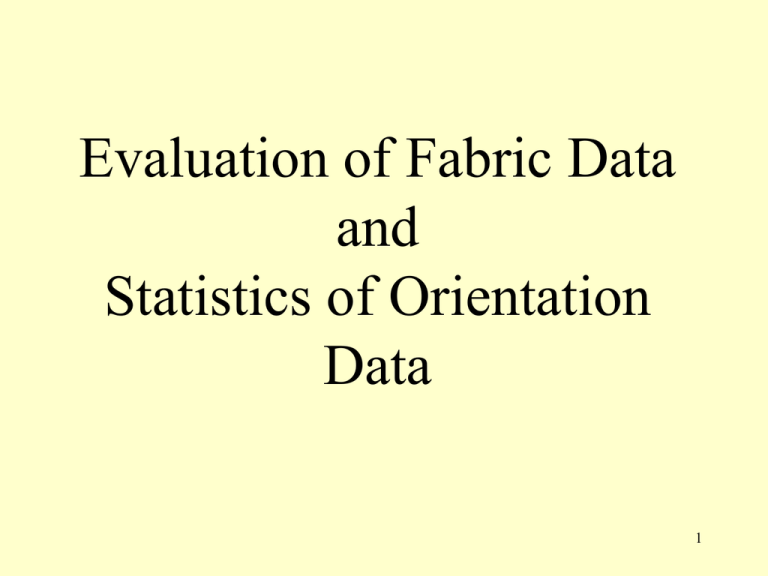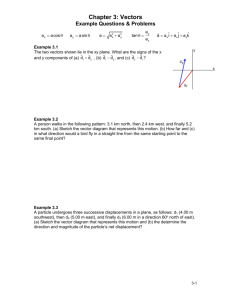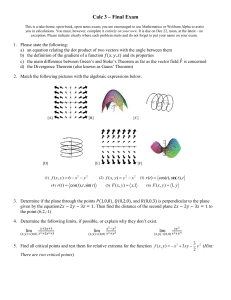PowerPoint-Präsentation
advertisement

Evaluation of Fabric Data and Statistics of Orientation Data 1 Which types of data are most common in structural geology? 1) Deformation Data: Elongation [%] Shear strain [] Strain rate [d /dt] 2) (Paleo-) Stress Data [Mpa]: Stress Tensor (Stress Ellipsoid) Deviatoric Stress 3) Orientation Data: Field Measures (compass) Bedding, Schistosity, Lineation, etc. Lattice Preferred Orientation Remote Sensing Data Measures of Orientation Data are: azimuth and dip angle [/] 2 Classical Methods of Evaluation of Orientation Data: 1) Data distributed in 2 dimensions Rose diagrams: 2) Data distributed in 3 dimensions: Equal area projections (Schmidt, 1925) 3 It is not possible to apply linear statistics to orientation data. Example: The mean direction of the directions 340°, 20°, 60° is 20° The arithmetic mean is: (340 + 20 + 60) / 3 = 140 this is obviously nonsense. Statistical masures of orientation data can only be found by application of vector algebra. The mean direction can be derived from the vector sum of all data. vi n i 1 (n = number of data) 4 What is the difference between orientation data and other structural data? 1) They have no magnitudes, i.e. they are unit vectors: vi 1 2) Most of them (bedding, schistosity, lineations) have no polarity! This type of orientation data can be described as bipolar vectors or axes: v 5 How can we convert measures of orientation data (/) into vectors of the form (Vx, Vy, Vz) ? with v = 1 we receive: Vx = cos cos Vy = sin cos Vz = sin 6 Vector sums of orientation data: if the data are real vectors with polarity (palaeomagnetic data) we have max. isotropy in a random distribution vi 0 n i 1 and max. anisotropy in a parallel orientation: vi n n i 1 7 Measures derived from addition of vectors (orientation data): n The Resultant Length Vector: R vi 1 The Vector Sum: R 2 2 n n n 1 v 1 xi 1 yi 1 z n The Normalized Vector Sum: R 2 The Centre of Gravity: R S R R n Azimuth and Dip of the Centre of Gravity: 1 xR R n xi 1 1 yR R n y 1 i 1 zR R n z 1 i yR AR arctan xR arcsin z R 8 Problems of axial data: If the angle between two lineations is > 90°, the reverse direction must be added. 9 Flow diagram for the vector addition of axial data: 10 What is the vector sum of axial data? In case of max. anisotropy (parallel orientation) the sum will equal to the number of data, but what is the minimum (max. isotropy)? It can be shown that the vector sum of a random distribution of axial data is: n n vi 2 i 1 we conclude that the vector sum of any axial data must be in the limits: n R n 2 11 From these limits a measure for the Degree of Preferred Orientation (R%) can be found: R% 2R n n 100 12 Distributions: The Spherical Normal Distribution (unimodal distribution) Fisher Distribution (Fisher, 1953) F x0 , y 0 , z 0 , k Concentration-Parameter (k): n 1 ˆ k 0 k̂ Watson, 1966 n R For axial data: 2 k̂ Wallbrecher, 1978 13 Fisher Distribution k k cos Density Function: f (, ) e 4 sinh k Probability Measures: The Cone of Confidence: 1 n R n 1 1 arccos 1 1 P R P is the level of error (0.01, 0.05 or 0.1 are common levels, they equal 1%, 5% or 10% of error) 14 The Cone of Confidence 15 Geometric equivalent of the concentration parameter: Isotropic distribution in a small circle with apical angle R% cos 2 1 1 n From this we derive the spheric aperture: arcsin 2 kˆ For large numbers of data: arcsin 2 k̂ 16 Examples for Spherical Aperture and Cone of Confidence Fold axes Minucciano Tuscany Fold axes Rio Marina (Elba Italy Confidence = 99% Yellow: Spherical aperture Green: Cone of confidence 17 Spherical Normal Distribution 18 Aus Wallbrecher, 1979 Significant Distributions Umgezeichnet nach Woodcock & Naylor, 1983 19 The moment of Inertia (M) Rotation axis isu . Length of u is undefined: u 1 v is the radius of the globe:v 1 all masses m are: m=1 Moment of Inertia:M m a 2 For a sin 2 a 1 cos 2 M a2 the entire Globe: M Kugel i 1 ai n u v cos u v u v 2 cos u x v x u y v y u z v z M 1 u x vx u y v y u vz M 1 cos 2 2 M 1 (u x vx u y v y u z vz 2u x vxu y v y 2u x vxu z vz 2u y v y u z20vz ) 2 2 2 2 2 Axes of inertia: Cluster Distribution: Great circle distribution: Partial Great circle: 21 The Orientation Matrix 2 vx M 1 u v y vx vx v y 2 vy vz vx vx vz v y vz vz v y vz 2 x nu x y y x z y z z 2 i M Kugel 2 i i i i i i i 2 i 22 The Orientation Matrix and it´s Eigenvalues: Orientation Tensor n 2 xi 1 n L xi y i 1 n xi z i 1 n yi 1 2 n y z i i 1 Eigenvalues: 1 2 3 n normalized: 1 2 3 1 Eigenvectors: 2 n zi 1 12 3 23 The Eigenvalues of Cluster-Distributions 1 2 1 2 sin 3 2 2 3 1 sin 3 24 Eigenvectors of a Cluster Distribution Foliation Psarà Island Greece Spherical Aperture Eigenvectors (length indicates size of eigenvalues. Sum equals the radius of the diagram.) Cone of Confidence 25 Eigenvectors of a Great Circle Distribution Campo Cecina Alpe Apuane Italy Eigenvectors (length indicates size of eigenvalues. Sum equals the radius of the diagram. 26 Eigenvalues of Partial Great Circles 1 2 2 sin 2 2 From this we derive a measure for the length of a partial great circle. We call this measure the circular aperture (): 2 arcsin 22 27 Examples for Partial Great Circles Alpe Apuane, Italy 3 0.66 3 0.76 2 0.2 2 0.3 1 0.04 Punta Punta Bianca Bianca 1 0.03 1 0.04 Gronda Gronda heavy lines = circular aperture 2 0.26 Ponte Stazzemese 3 0.71 1 0.02 Forno 2 0.21 3 0.77 28 2-Cluster-Distributions 90 80 70 60 1 0 2 sin 2 3 cos 2 2 40 20 10 0 } 30 0.1 0.2 0.3 0.4 0.5 0.6 0.7 0.8 0.9 1 29 2 Eigenvalues and –vectors of typical distributions isotrop, Random Distribution S p h e r e Stretched rotational ellipsoid (cigar) Girdle Distribution 2-Cluster Distribution Flat rotational ellipsoid (Disk) T h re ea x ia l e llip so id 1 1 2 3 3 1 2 3 1 0 1 2 3 2 1 2 3 not defined 3 incentre of the cluster 1 and 2 not defined 1 is the B-axis 2 and 3not defined 2 and 3 on the great circle through both clusters;1 is 30 the pole The Woodcock-Diagram Cluster: 1<m< 8 ln( 3 / 2 ) m ln( 2 / 1 ) Girdle: 0<m<1 Umgezeichnet nach Woodcock, 1977 ln( 2 / 1 ) G% [Gon] arctan ln( 313 / 2 )



